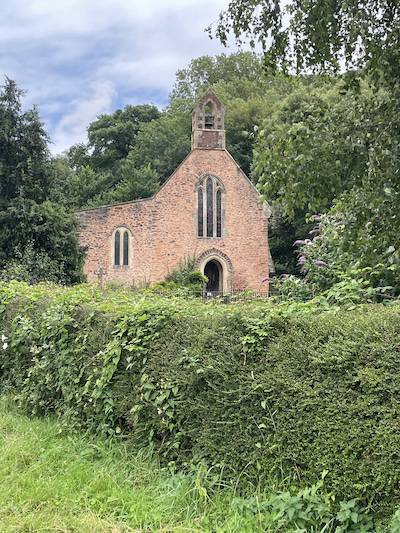
The Haccombe Horseshoes
These ancient horseshoes are nailed to the door of St Blaise, Church, Haccombe, Devon.
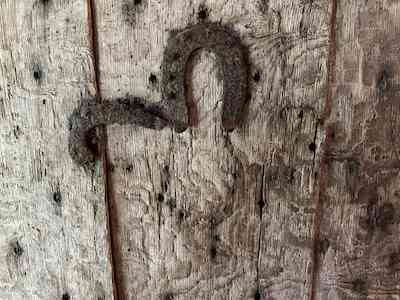
Only one and half horseshoes still cling there today, but the marks where nails once held the other two shoes from a set or four are clearly visible in the weathered wood.
The Legend
Legend has it that these horseshoes belonged to a valiant steed, victor in a most extraordinary race to decide a reckless wager to decide the ownership of the Manor of Haccombe.
The story goes that at some time — perhaps it was during the sixteenth century — two local landowners, a Carew and a Champernowne, each claimed that the manor was their property. They decided to settle the long-running argument by the outcome of wager on an extremely hazardous horse race.
The two men each chose the best horse from their stables and rode out side by side into the sea from Tor Bay. The one who could swim his horse farthest was to be declared the winner and claim the manor. They breasted the waves for a long time, neck and neck until Carew started to pull ahead. His lead increased until he had left Champernowne far behind. But then Carew heard a shout, a desperate cry for help. He looked back and saw that Champernowne’s horse had died under him leaving the ill-fated rider struggling in the water, Carew turned back and rescued his rival. He pulled him up onto his own mount and the valiant horse, exhausted after carrying his master so far into the sea, must now carry two men. By some miracle they came safely back to the shore. Carew was so amazed at the strength of the brave animal that he declared that his horse should do no more work, but be put out to grass. The horseshoes, it is said, were removed and nailed to the church door, while the horse grazed on the green fields around Haccombe 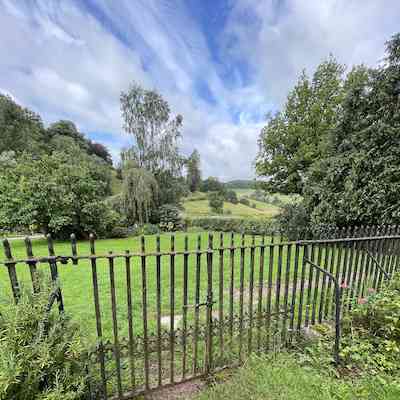 until it eventually died of old age.
until it eventually died of old age.
The Ballad of the Earl of Totnes
Various versions of the story have circulated over the years including a ballad, the lyrics of which are below. The song is supposed to have been written by a master of Exeter Grammar School in the early part of the nineteenth century. It suggests that the wager was between the Earl of Totnes, mounted on a Devonshire roan and Sir Arthur Champernowne of Dartington on a fleet Barbary courser. However, there are a number of reasons to doubt that these men were involved in a race as the ballad describes.
George Carew, 1st Earl of Totnes was born May 29, 1555, the son of George Carew, dean of Windsor. Readers of my novel A Woman of Noble Wit will recall his father as Katherine Champernowne/Raleigh’s uncle.
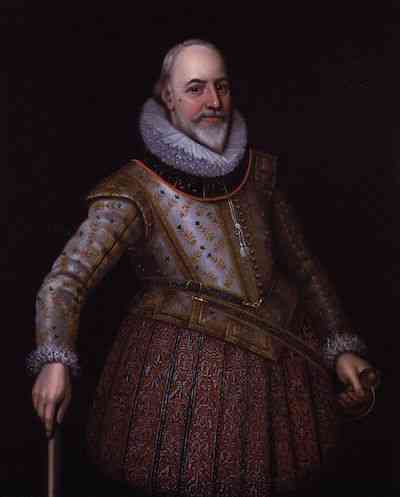
Portrait of George Carew Ist Earl of Totnes
Sourced via Wikimedia commons — National Portrait Gallery,
Given what is recorded of his career in the service of Queen Elizabeth it seems rather unlikely that this George Carew would have found the time to be one of the protagonists in the supposed race. It is even more unlikely that he would have fallen to his knees and chanted "Ave Maria's" as described in the ballad since he was, throughout his life a staunch protestant. A well respected soldier and diplomat, George’s distinguished military career began in Ireland in 1574. In 1578 he joined Sir Humphrey Gilbert ( Katherine Champernowne/Raleigh’s second son) on his first abortive attempt at voyage for North America. Knighted in 1586, George became Master of the Ordnance of Ireland and in the same year and in 1592 was appointed to the same role for the whole of England. He accompanied Robert Devereux, 2nd Earl of Essex, on the raid on Cádiz, Spain, in 1596 and on the expedition to the Azores in 1597. He attended Robert Cecil as Ambassador to France in 1598. Appointed treasurer at war to Essex in Ireland in March 1599 he remained in Ireland after Essex’s sudden departure in September of the same year. Carew was appointed a lord justice and then, in 1600, president of the province of Munster. In 1605, two years after his return to England in failing health, King James I made him Baron Carew of Clopton. He was master of the ordnance from 1608 to 1617, and in 1618 tried unsuccessfully to prevent the execution of Katherine’s son, Sir Walter Raleigh. It was only in 1625 that on 5 February 1626, Carew Charles 1 made him Earl of Totnes. He died on March 27, 1629. George Carew, 1st Earl of Totnes had a daughter but no legitimate sons and his titles became extinct upon his death.
During George’s lifetime two men bear the name and title and name “Sir Arthur Champernowne”. The first, Katherine Champernowne/Raleigh’s brother who lived at Dartington Hall and was Vice Admiral of the Fleet of the West, died in 1578. The second is perhaps a more plausible candidate.
Sir Arthur Champernwone of Modbury, was the second son of Henry Champernowne, Katherine’s nephew. This Sir Arthur, born around 1560 and one of Prince’s Worthies of Devon, is a fascinating but little known character who had a varied career. In his youth he was an informant of Walsingham in France and elsewhere in Europe; he was with Leicester in the Low Countries; he designed renewed fortifications at Plymouth in the early 1590s and he too accompanied Essex on the ill-fated Azores expedition. Knighted by Essex in Ireland on 12 July 1599, Arthur died there later in the same year.
The ballad throws up another inconsistency in suggesting that the Arthur Champernowne involved in the horse race returned to the Abbey of Torre to rest. Torre Abbey survived until 1539 when it was one of the last monasteries in Britain to be suppressed by Henry VIII. The monastic buildings were sold to John St Leger in 1543 and passed through two more owners before Thomas Ridgeway transformed the monastic west range into a comfortable dwelling in 1598. It later ecame the home of the Cary family, (Not to be confused witht he Carews!).
Did such a race really take place?
Like most legends this tale may have grown from a kernel of truth but documentary evidence is proving elusive.
I would dearly love the two riders to be Katherine Raleigh’s brother, Sir Arthur of Dartington and his cousin Sir Peter Carew, as what I have discovered of their personalities suggests this is just the sort of thing they would do! But alas, as yet I have found no evidence of any dispute over ownership of the manor, the date of the supposed wager or the identity of the two riders.
Of course, we should not forget that the horseshoes may have been nailed to the door for another reason entirely. It has long been the custom to nail horseshoes to stables and other buildings as iron was thought to offer protection against witches …
The Earl of Totnes
The feast was over at Haccombe Hall
And the wassail bowl had been served to all,
When the Earl of Totnes rose from his place
And the chanters came in to say the grace.
But scarce was ended the holy rite
When there stepped from the crowd a valiant knight;
His armour bright and his visage brown,
His name was Sir Arthur Champernowne.
"Good Earl of Totness I've brought with me
My fleetest courser of Barbary;
And whether good or ill betide,
A wager with thee I mean for to ride."
"No Barbary courser do I own,
But I have," quoth the Earl, "a Devonshire roan;
And I'll ride for a wager by land or by sea,
The roan 'gainst the courser of Barbary."
"'Tis done," said Sir Arthur, "already I've won;
And I'll stake my manor of Dartington
'Gainst Haccombe Hall and its rich domain."
So the Earl of Totnes the wager has ta'en.
"To horse! To horse!" resounds through the hall,
Each warrior's horse is led from its stall;
And with gallant train over Milburn Down
Ride the bold Carew and the Champernowne.
And when they come to the Abbey of Tor,
The abbot came forth from the western door,
And much he prayed them to stay and dine;
But the earl took nought but a goblet of wine.
Sir Arthur he raised the bowl on high
And prayed to the Giver of Victory;
Then drank success to himself in the course,
And the sops of the wine he gave to his horse.
Away they rode from the Abbey of Tor
Till they reached the inlet's curving shore;
The earl plunged first in the foaming wave,
And was followed straight by Sir Arthur the brave.
The wind blew hard and the waves beat high,
And the horses strove for the mastery;
Till Sir Arthur cried, "Help, thou bold Carew!
Help, if thou art a Christian true!
"O save for the sake of that lady of mine
Good Earl of Totnes, the manor is thine!
The Barbary courser must yield to the roan,
And thou art the Lord of Dartington."
The Earl his steed began to restrain,
And he seized Sir Arthur's horse by the rein;
He cheered him by words and gave him his hand,
And brought Sir Arthur safe to land.
Then Sir Arthur, with sickness and grief opprest,
Lay down in the abbey chambers to rest;
But the earl he rode from the Abbey of Tor
Straight forward to Haccombe chapel door.
And there he fell on his knees and prayed
And many an "Ave Maria" said;
Bread and money he gave to the poor,
And he nailed the roan's shoes to the chapel door.
This version of the lyrics of "The Earl of Totnes", a Devonshire ballad is taken from https://www.traditionalmusic.co.uk/folk-song-lyrics/Earl_of_Totnes.htm
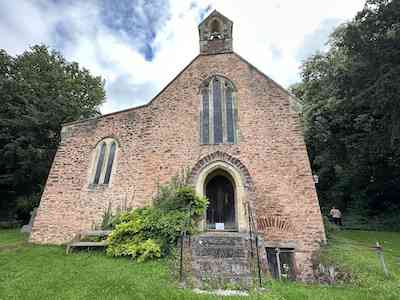
St Blaise Church is tucked away in a green valley where it is easy to imagine that heroic horse living out his days amongst Devon’s rolling hills.
The church was built in 1233 by Sir Stephen de Haccombe on his return from the Fifth Crusade and has been associated with the Carew family for over 500 years.
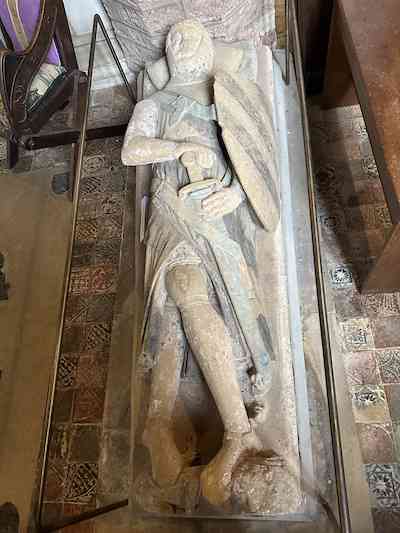
The church is noted for its fine collection of mediaeval effigies, including tan amazingly well preserved one of Sir Stephen himself (shown here) and an unusual alabaster effigy marking a heart burial. There are also brasses and a fine collection of Mediaeval and Moorish floor-tiles, and Flemish glass.
If you have enjoyed this article please share it on social media using the lnks below
